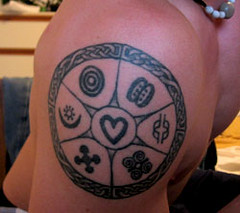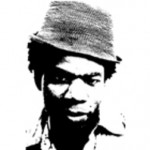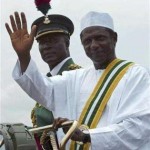
- Image by macgenie via Flickr
You probably have seen a few of these symbols before but never knew what they were. Adinkra symbols are now being used as tattoos.
ADINKRAHENE: “Chief of the adinkra symbols”
This is symbol of greatness, charisma and leadership. This symbol is said to have played an inspiring role in the designing of other symbols. it signifies the importance of playing a leadership role.
AKOBEN: “war horn”
symbol of vigilance and wariness.Akoben is a horn used to sound a battle cry.
AKOFENA: “sword of war ”
symbol of courage, valor, and heroism. The crossed swords were a popular motif in the heraldic shields of many former Akan states. In addition to recognizing courage and valor, the swords can represent legitimate state authority.
AKOKO NAN: “the leg of a hen”
symbol of nurturing and discipline. The full name of this symbol translates to “The hen treads on her chicks, but she does not kill them.” This represents the ideal nature of parents, being both protective and corrective. An exhortation to nurture children, but a warning not to pamper them.
AKOMA: “the heart”
symbol of patience and tolerance.According to Agbo, when a person is said to “have a heart in his stomach,” that person is very tolerant.
AKOMA NTOSO: “linked hearts”
symbol of understanding and agreement.
ANANSE NTONTAN: “spider’s web”
symbol of wisdom, creativity and the complexities of life. Ananse, the spider, is a well-known character in African folktales.
ASASE YE DURU: “the Earth has weight”
symbol of providence and the divinity of Mother Earth.This symbol represents the importance of the Earth in sustaining life.
AYA:”fern”
symbol of endurance and resourcefulness. The fern is a hardy plant that can grow in difficult places. “An individual who wears this symbol suggests that he has endured many adversities and outlasted much difficulty.” (Willis, The Adinkra Dictionary)
BESE SAKA:”sack of cola nuts”
symbol of affluence, Macht, abundance, plenty, togetherness and unity. The cola nut played an important role in the economic life of Ghana. A widely-used cash crop, it is closely associated with affluence and abundance. This symbol also represents the role of agriculture and trade in bringing peoples together.
BI NKA BI: “No one should bite the other”
symbol of peace and harmony. This symbol cautions against provocation and strife. Das Bild wird auf zwei Fische beißen einander tails basierend.
Boa ME AND ME MMOA hat: “Hilf mir und lass mich dir helfen”
Symbol der Zusammenarbeit und gegenseitige Abhängigkeit
Quelle: “Cloth als Metapher” von g · f. Kojo Arthur
DAME-DAME: Namen eines Brettspiels
Symbol der Intelligenz und Einfallsreichtum
Denkyem: “Krokodil”
Symbol der Anpassungsfähigkeit. Das Krokodil lebt im Wasser, noch atmet die Luft, demonstriert die Fähigkeit, den Umständen anpassen.
DUAFE: “Holzkamm”
Symbol der Schönheit und Sauberkeit; Symbole der weiblichen Qualitäten erwünscht. Die Bedeutung dieses Symbols ist etwas anders, dadurch gekennzeichnet, “The Adinkra Dictionary” und “Die Werte der Adinkra Symbole”; der ehemalige betont abstrakteren Qualitäten feminine Güte, Liebe und Fürsorge, während die letzteren hat eine wörtliche Auslegung, sucht sein Bestes und gute Hygiene. In jedem Fall, die DUAFE war ein begehrter Besitz der Akan Frau, used to comb and plait her hair.
DWENNIMMEN: “ram’s horns”
symbol of humility together with strength. The ram will fight fiercely against an adversary, but it also submits humbly to slaughter, emphasizing that even the strong need to be humble.
EBAN: “fence”
symbol of love, safety and security. The home to the Akan is a special place. A home which has a fence around it is considered to be an ideal residence.
The fence symbolically separates and secures the family from the outside. Because of the security and the protection that a fence affords, the symbol is also associated with the security and safety one finds in love.
EPA:”handcuffs”
symbol of law and justice, slavery and captivity. Adolph Agbo, in “Values of Adinkra Symbols” notes that handcuffs were introduced in Africa as a result of the slave trade, and later became popular among chiefs in cuffing offenders of the law. “The symbol reminds offenders of the uncompromising nature of the law. It however discourages all forms of slavery.”
ESE NE TEKREMA: “the teeth and the tongue”
symbol of friendship and interdependence. The teeth and the tongue play interdependent roles in the mouth. They may come into conflict, but they need to work together.
FAWOHODIE: “Unabhängigkeit”
symbol of independence, Freiheit, emancipation
“From the expression: Fawodhodie ene obre na enam.
Literal translation: “Independence comes with its responsibilities.”
– from Cloth As Metaphor by G.F. Kojo Arthur
FIHANKRA:”house/compound”
symbol of security and safety. Typical of Akan (Asante) architecture, the communal housing compound has only one entrance and exit.
FOFO: “yellow flowered plant”
symbol of jealousy and envy. “When the fofo’s petals drop, they turn into black spiky-like seeds. The Akan liken the nature of this plant to a jealous person.”
– The Adinkra Dictionary by W. Bruce Willis
There is a Akan proverb associated with this symbol: “What the fofo plant wishes is that the gyinantwi seeds turn black.”
FUNTUNFUNEFU-DENKYEMFUNEFU: “Siamese crocodiles”
symbol of democracy and unity. The Siamese crocodiles share one stomach, yet they fight over food. This popular symbol is a remind that infighting and tribalism is harmful to all who engage in it.
GYE NYAME: “außer für Gott”
symbol of the supremacy of God. This unique and beautiful symbol is ubiquitous in Ghana. It is by far the most popular for use in decoration, a reflection on the deeply religious character of the Ghanaian people.
HWE MU DUA: “measuring stick”
symbol of examination and quality control. This symbol stresses the need to strive for the best quality, whether in production of goods or in human endeavors.
HYE WON HYE: “that which does not burn ”
symbol of imperishability and endurance
This symbol gets its meaning from traditional priests that were able to walk on fire without burning their feet, an inspiration to others to endure and overcome difficulties.
KETE PA: “good bed ”
symbol of a good marriage.
From the expression that a woman who has a good marriage is said to sleep on a good bed.
See Cloth As Metaphor by G.F. Kojo Arthur, pp. 87-89
KINTINKANTAN: “puffed up extravagance”
symbol of arrogance
KWATAKYE ATIKO: “hair style of an Asante war captain”
symbol of bravery and valor
“This symbols is said to be a special hair style of Kwatakye, a war captain of old Asante.
The symbol has come to represent bravery and fearlessness. It is also given as an earned title to any brave son of an Akan community.”
– Die. Bruce Willis, The Adinkra Dictionary
MATE MASIE: “What I hear, I keep”
symbol of wisdom, knowledge and prudence. The implied meaning of the phrase “mate masie” ist “I understand”. Understanding means wisdom and knowledge, but it also represents the prudence of taking into consideration what another person has said.
ME WARE WO: “I shall marry you ”
symbol of commitment, perseverance
From the expression “No one rushes into the job of mixing the concrete for building the house of marriage.”
See Cloth As Metaphor by G.F. Kojo Arthur, pp. 89, 163.
MMERE DANE: “time changes ”
symbol of change, life’s dynamics
NKONSONKONSON: “chain link”
symbol of unity and human relations
A reminder to contribute to the community, that in unity lies strength.
NYAME DUA: “tree of god” – altar
symbol of God’s presence and protection
The Nyame Dua is a sacred spot where rituals are performed. Erected in front of the house or compound, it is crafted from a tree that has been cut where three or more branches come together. This stake holds an earthenware vessell filled with water and herbs or other symbolic materials for purification and blessing rituals.
NKYINKYIM: “twisting”
symbol of initiative, dynamism and versatility.
NYAME NNWU NA MAWU: “God never dies, therefore I cannot die”
symbol of God’s omnipresence and the perpetual existence of man’s spirit
This signifies the immortality of man’s soul, believed to be a part of God. Because the soul rests with God after death, it cannot die.
NYAME NTI: “by God’s grace”
symbol of faith and trust in God. similar to Gye Nyame
According to The Adinkra Dictionary by W. Bruce Willis: “This stalk is depicted as the staff of life in many cultures. It symbolizes to the Akan that food is a basis of life and that they could not survive if not for the food that God has placed here on Earth for their nourishment. ”
NYAME YE OHENE:”God is King ”
symbol of majesty and supremacy of God
OKODEE MMOWERE:”the talons of the eagle”
symbol of strength, bravery, Macht. The eagle is the mightiest bird in the sky, and its strength is concentrated in its talons. The Oyoko clan, one of the nine Akan clans, uses this symbol as their clan emblem.
OSRAM NE NSOROMMA: “The Moon and the Star”
symbol of love, faithfulness, harmony. This symbol reflects the harmony that exists in the bonding between a man and a woman.
Sprichwort: “Kyekye pe aware.” (The North Star has a deep llove for marriage. Sie ist immer in der Luft auf die Rückkehr des Mondes, ihr Ehemann.)
–von The Adinkra Wörterbuch)
SANKOFA: “zurückbringen und es”
Symbol der Bedeutung des Lernens aus der Vergangenheit
Neueste Artikel von cadmin (alle ansehen)
- Die Geschichte eines Ghetto Boy - Juni 28, 2015
- The Rise of The Next Gen. Marley’s | Bob Marley’s grandsons (VIDEO) - Mai 8, 2015
- Mittlerweile irgendwo in Schweden, diese schwedischen afrikanischen Tänzer… - März 24, 2015



